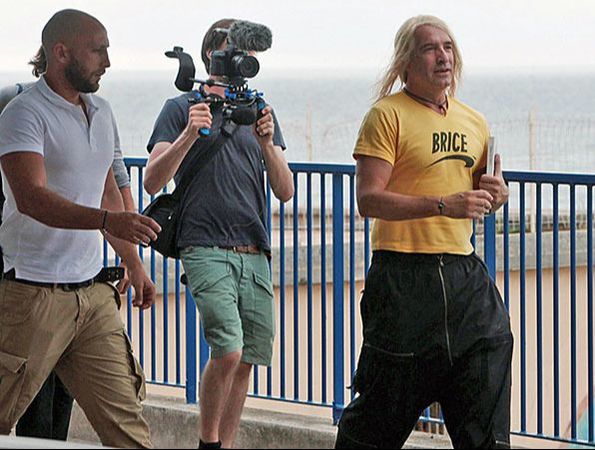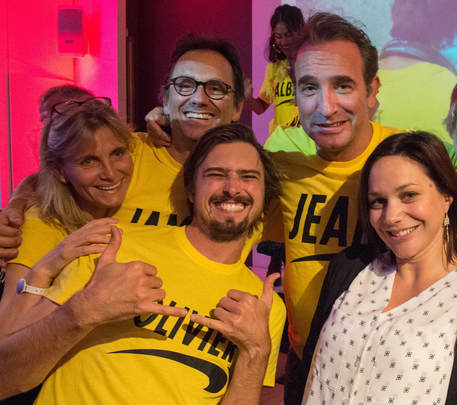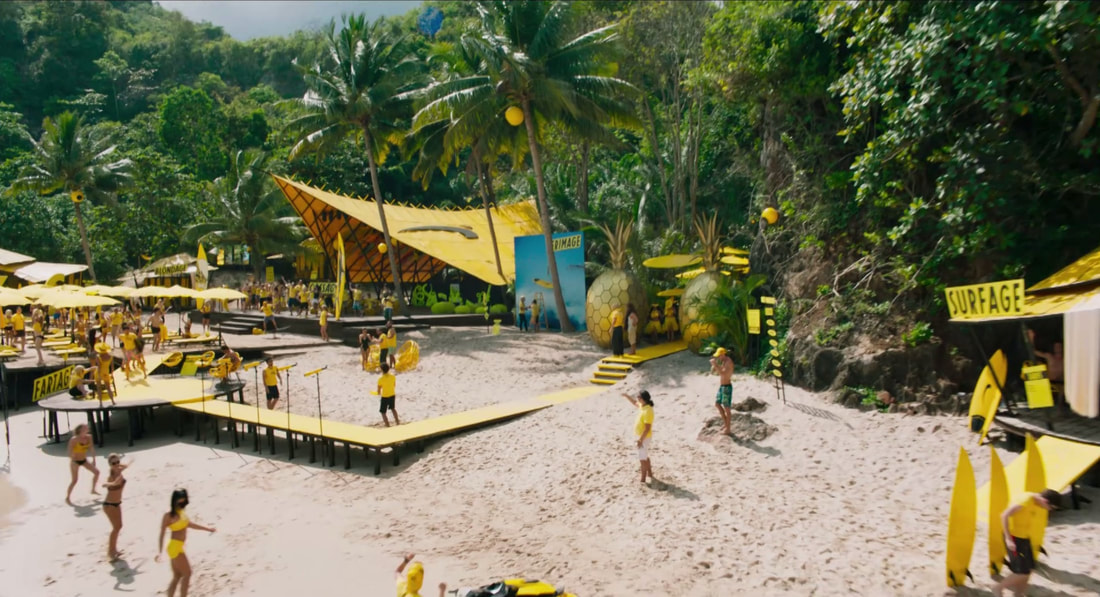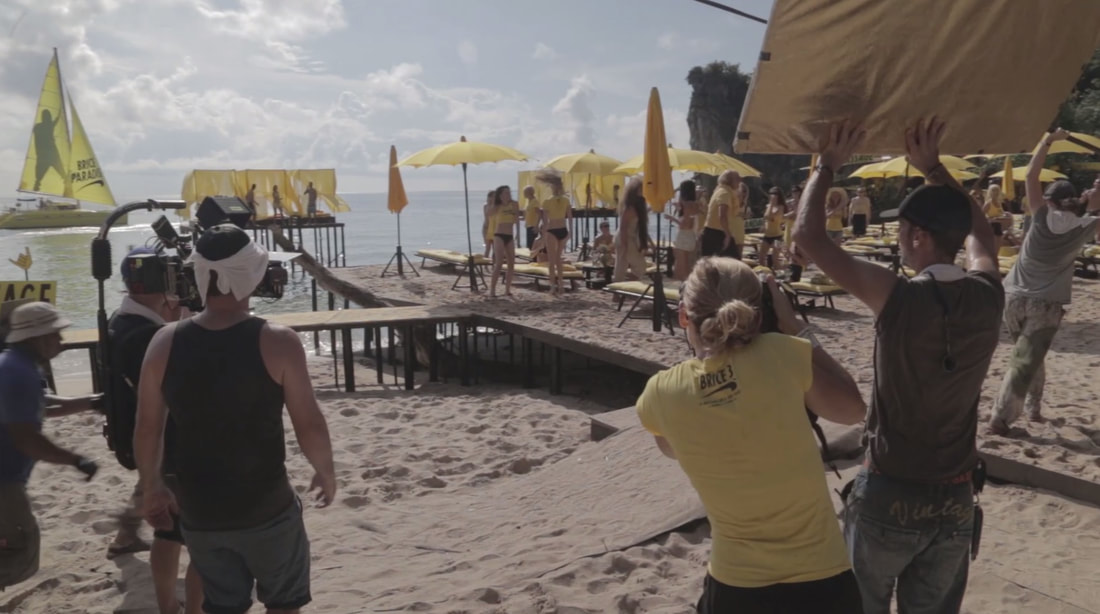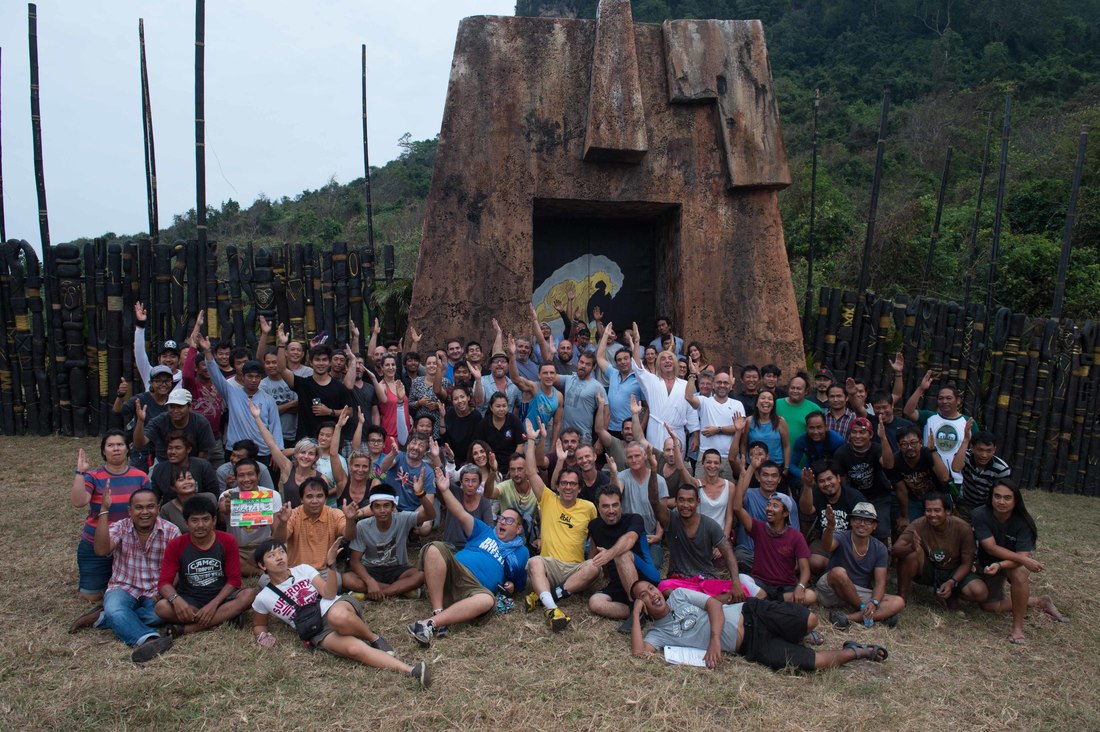Psi
Menu
II - PRODUCTION - THE LIVES
Chapter 9
A Making-Of in The Making-Of: Brice de Nice, 3
(Sept 2015 - June 2016)
A Making-Of in The Making-Of: Brice de Nice, 3
(Sept 2015 - June 2016)
|
Even though it is made up of English words, a “making-of” is an expression used by the French to call what the English more commonly call a “behind-the-scenes” documentary. It’s what you often find on DVD extras, and is this kind of video that I was hired to make for the film “Brice de Nice, 3”, which was shot between September 2015 and February 2016.
When James Huth, the director, called to offer me the job, he still needed to send me to the producer’s office to get the final seal of approval. The movie was produced by Mandarin Films, led by two brothers, Eric and Nicolas Altmayer. Aside from Brice, they are also mostly known for producing the OSS 177 franchise, also starring Jean Dujardin. When I met with Nicolas Altmayer in his office, I could tell that he was a little skeptical about hiring me given my lack of experience. I was to produce a 30-minute “behind-the-scenes” video that would be on the DVD and used as promotional material for various outlets on the Internet and television. He informed me that the shoot was divided in two separate periods: there was a first 5-week shoot in France, followed by a 2-month break and then a second 5-week shoot in Thailand. Altmayer made it very clear to me that the first part of the shoot would be enough to make the behind-the-scenes, and so that I would not be going to Thailand
Nice...
On September 14, 2015, I flew to Nice, in the south of France, to join the cast and crew for the first day of the shoot. Pretty sure that day was in the top 5 most nerve-wracking days of my life. I knew what I had to do for my job, I had binge watched a ton of behind-the-scenes features and read interviews by people who had directed them, so I knew what was expected of me, but on the first day, I was overwhelmed: I had never set foot on a real film set before, and aside from James, I knew absolutely no one. I quickly realized this made it particularly hard to perform the job I was there to do: the kind of footage I needed to get requires both good navigation of the film set (in order to know where to be and, more importantly, where not to be) and good relations with the crew (so that they behave naturally in front of my camera and don’t feel weirded out by me creeping around them). During the first few days of shooting, I genuinely felt like an imposter, like I had somehow smuggled my way on set and that sooner or later people would notice and I’d get fired. To compensate, the first couple of weeks I kept a low profile and shot ridiculous amounts of footage (the first day, I had 7 hours of footage out of a 10-hour day). I was so worried of missing something that I tried to film everything. Not only was this exhausting to shoot, but it cost me hours after the end of the day to un-rush it all. In time, however, I learned to know what was worth filming and what was clearly not going to make the cut – and so, by the end of the shoot, I was averaging 2 hours of footage per day.
As I progressively grew more comfortable on set and familiar with the crew, my initial anxiety wore off and transformed itself into the excitement of shooting something interesting. Two different voices started battling inside my head for control of the camera: on one side was the “filmmaker-for-hire,” the one who was performing a professional service specifically to deliver a paint-by-numbers product, and on the other was the “filmmaker-by-passion,” the one who wanted to direct something original and fun. In the end, I tried to accommodate the two, in order to make a behind-the-scenes documentary that ticked all the expected boxes, and that would also try to be original and engaging. And so this led me to experiment with what I shot, capturing more than just “the crew at work” footage, but also more intimate and off-the-cuff moments that would later prove to be essential.
After Nice, we shot near Bordeaux for 2 weeks and then returned to Paris to shoot in the TSF studios in Epinay, where my whole “Brice” journey began. While in the studios, I was able to get the shots I needed for my Paris life. James was so helpful with this: he cameoed as my in-film actor and tasked his DP, Stéphane Le Parc, with operating my camera for my scenes, and other crew members played along around me.
As the first 5-week part of the shoot ended, I wanted to prepare a video to show at the wrap party, in part as a “thank you and goodbye” to the crew, and also in part as a “here’s what I can do” to the producers so that they’d hopefully remember my name for the future. I had at my disposal so much great footage that wouldn't make it into the official behind-the-scenes, so over the course of a week, I edited two 20-minute videos: one for the whole crew and one specifically for Dujardin (containing clips of his family and friends who came to set). The first video was projected half-way through the wrap-party. I was worried that people, who were busy drinking and networking, would only endure a couple minutes of my video before tuning out, but that was not the case. The video kept everyone’s attention to the final second, like a long pause midway through the party, and the reception afterwards was beyond anything I could have hoped for. Jean Dujardin and James thanked me for the videos and Nicolas Altmayer, the producer, told me that in 20 years of experience, he’d never been moved by a behind-the-scenes crew video in such a way. That evening, James and Jean insisted with him that I be taken to Thailand for the second part of the shoot, and the following Monday, I got a call from the production office asking for my passport information.
Thailand...
At that moment, I felt like I was being lifted by some invisible tidal wave of good fortune. A few weeks earlier, I was clutching at tiny straws in my quest for a film set and now I was mingling with James Huth, Jean Dujardin and Nicolas Altmayer on my way to Thailand. The biggest achievement for me at that point was to have been able to show these people that I could do something worthwhile – something they were willing to pay me for.
On December 15, I flew to Thailand for the second half of the shoot. And while the couple months we spent there were fun and interesting for many reasons (Bangkok street food and full moon parties among them), I’ll only focus on one here. Most of our shoot was on a beach resort specifically built for the film. It took months to construct, particularly because the actual beach had to be almost entirely covered by a huge platform resting on a steel structure, itself covered in sand to make the customer lounging area higher and bigger, with bars and a nightclub surrounding it. On a regular day, the set would have anywhere around 200 people working there, with crew, cast and extras everywhere.
Mid-way through the shoot, on a day-off, I woke up at the hotel and as I walked across the grounds towards the breakfast restaurant, there was an eeriness in the air: the sky was dark with low heavy clouds, the palm-trees were swaying in the wind and the sea was abnormally high, encroaching on the land beyond the beach. Second later, I saw Anne, the set designer, running panicked towards a mini-van; as she saw me, she yelled at me to grab my camera and come with her. An anxious 40-minute drive later, I was capturing what was by all definitions a disaster for the film but absolute gold for my behind-the-scenes documentary: that night, a storm had completely destroyed the set, sweeping most of it to sea and leaving the rest in ruin. The main platform had been shattered, exposing the steel structure beneath, bent and broken like an eviscerated shipwreck. Pascal, the production manager, was the only senior crew member already on the scenes, and the first thing he said was: “It’s over. We’re going back to Paris.” My initial thought was the same: how could we possibly finish the shoot?
But then... a vision appeared from between the broken palm-trees: Was it a bird? Was it a plane?
No, it was James, the director. His reaction to seeing the destruction of his set was one of the greatest examples of smooth crisis management and/or balls-to-the-wall-refusal-to-see-reality-in-the-face I have ever witnessed firsthand. He overlooked the disaster zone, let people console him about packing up, nodded with a smile and proclaimed: “We shoot tonight!” He sat down among the rubble, opened his laptop and started planning the rescue operation. So many parameters had to be taken into account: how many hours could we make the extras work, when did our supporting cast have to leave, when was the yellow elephant available, planning issues with shooting days and nights, security issues relating to electricity and lights, what parts of the set could be quickly repaired and which had to be thrown out, etc. As other key members of the crew showed up (DP, ADs, grips, etc.), everyone contributed to solving the riddle and, sure enough, that night we were shooting in what was left of the set, while off-camera, welders, painters and every possible handy-man were working to fix what could be salvaged for the following days.
Of all the lessons I learned on set, this was surely the most inspiring – another example of how willpower can overcome some pretty daunting challenges. Because I’m sure that when James set foot on the rubble, he was just as aware as anyone else that this signaled the end of the shoot, and that if he had called off the production, no one would have bat an eye-lid. But upon saying “We shoot tonight,” he was convincing himself as well as everyone else of something that was still genuinely uncertain, thus forcing one future to happen over another.
Lessons from a movie set
Returning back to France after the shoot to edit the behind-the-scenes, I had time to reflect on this experience. When I first met James and he offered me the job, he told me that shooting a behind-the-scenes was the best film-school you could find, and he was right: not only are you tasked with shooting a small-scale film yourself, but you have an in-depth access to all aspects of a full-scale film. I picked up the language, identified the different positions and how they usually operate, and learned to read the internal politics of a film crew (who has power in what instances, whose job is usually unpopular, who is it good to have on your side, etc.). I also saw the true scale of such a production. In the past, I was always surprised by the length of credits at the end of feature films, often wondering why so many people had been involved. Now I get it – from pre-production, to the actual set crew, to post-production and all the people involved even for just half-a-day, a feature film is a mini-economy in itself.
More importantly, this experience confirmed to me that shooting films was what I wanted to do, and better, something I felt confident I could do. Before the shoot, I was curious how it would affect my ambition in pursuing this career: perhaps witnessing a professional film-set would either show me that it was not a place I wanted to be, or worse, confirm that it was a place I wanted to be but confront me with a task I simply was not up to. Thankfully, this wasn’t the case. First of all, I felt at home on set and was instantly envious of James’ position. The regimented nature of the film set was also something I hugely admired: everyone knows their responsibility, their strengths and weaknesses. It truly was a great example of human cooperation and task optimization, and I can only imagine the sense of empowerment and fulfillment that must come from being the captain of such a collective enterprise.
I cannot thank James enough for his trust. From the first time we met, he has been incredibly generous with me. Outside of the shoot, James met up with me several times, just for lunch, not to check on my behind-the-scenes, but to make sure I was happy at the amount of exposure I was getting to the filmmaking process, and whether I felt like I was learning interesting lessons. He would often revisit moments in the shoot, explaining what was actually going on beyond what was apparent – things I couldn’t see, hidden power struggles here and there, things that he would not tell me if he didn’t have a real desire to share some fundamental knowledge with me about the industry and the craft.
Finally, being part of the crew was incredibly enriching on a human level. Many crewmembers have become close friends and people I hope to work with again in the future. It was really inspiring to me how all these people with extremely diverse technical skill-sets conglomerated here to work on the basis of something someone had imagined – this wasn’t an object being manufactured, a building being constructed, a machine being engineered – this was a story thought up in someone's mind and being realized by the sweat of many hands. As I got to know the crew members, I was struck by how diverse their backgrounds were. Roll back time 15-20 years, and where today you have an Oscar-winning actor, a bankable filmmaker and a powerful producer, you had a key-maker, a dentist and an art dealer; where today you have a production manager, a prop-master and a stunt double, you had a mountain guide, a bar-owner and a bomb-squad diver. The sense of wonder at seeing all these seemingly unrelated trajectories converge for such an intense period of time was only equal to the sadness at seeing them all diverge just as quickly afterwards to go onto other adventures.
All in all, shoot and edit combined, my involvement with "Brice de Nice, 3" required my undivided attention for 8 months, during which time psi was put on hold. Upon finishing the edit and delivering the behind-the-scenes, I knew that the Altmayer brothers would be the first producers I would talk to about psi and my subsequent projects. Had I found the door or had the door found me? Either way, I knew where to knock.
|
[email protected]
© COPYRIGHT 2022. ALL RIGHTS RESERVED.
© COPYRIGHT 2022. ALL RIGHTS RESERVED.


